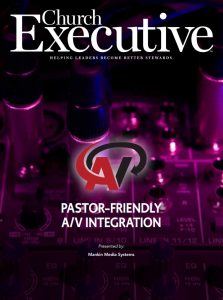

In the previous series installment, we talked about Steps 2 & 3: Design & Deploy. What denotes a movement to Step 4 — Defend — in the A/V system design process?
Wells: Defend takes a 50,000-foot view, recognizing that many churches in America are growing by deploying a multi-site strategy. They’re using ever more sophisticated technology to enable that, but they’re consistently challenged with attracting and retaining the people they need to keep the equipment operational.
Defend means that Mankin accepts responsibility for all these complexities, and turns them into product offerings that deliver solid, long-term solutions.
Ultimately, Defend is about outsourcing the most difficult 20 percent of knowledge, experience and troubleshooting capacity.
Defend consists of four distinct service offerings. What are those?
Wells: The first is Protect — our proactive monitoring, case management, technical support, preventive maintenance, and performance reporting that makes sure equipment is in tip-top shape all the time.
A piece of equipment is no more likely to fail on Sunday morning, but it is likely not to be paid attention to until then; so, Protect leverages the sophistication built into an ever-expanding amount of equipment. This way, we can tell when a piece of equipment ‘catches a cold’ on Tuesday and do something about it while there’s still time, before the weekend.
The second product is LifeLine, our real-time support. If Protect is listening all the time and proactively monitoring, then LifeLine is reactive; it’s a call-in service delivered on high-end intercom equipment that we supply to our clients, which allows for use in really noisy environments. It’s very-low latency and far more dependable than a cellphone.
We layer that with complete diagrams and a pre-flight checklist that provides volunteers with a list of all the things they must do to consistently deliver a quality performance every weekend.
With LifeLine, there’s also a full set of remote support tools. In the event of an issue, the church can have us log in and begin to troubleshoot. In the end, that will

either solve the problem, help them develop a workaround, or determine that it can’t be fixed — but the church can at least put together a backup plan.
The third service offering is Slipstream, an all-broadcast-grade IP streaming technology platform that allows multi-channel video, 16 channels of audio, and HD and 4K resolutions. With integrated time-delayed playback, it keeps up to a one-week archive, lending tremendous flexibility compared to other solutions on the market.
It has a low-latency mode that enables low-latency streaming on business-class internet connections. So, if you’re doing a live event and you want everything to be in real time, it can do that. It’s kind of a be-all-end-all, broadcast-based television network in a case.
The fourth is GameFilm, an archiving and review platform that takes HD video and High Fidelity audio feeds from all the church campuses, in real-time, and records them, making them available for a 30-, 60– or 90-day archive. Staff can go in and review, on one screen, all their campuses at one time. It’s completely automated and runs 24/7; no one has to remember to hit “record,” and it captures everything that happens in the room. Users can write notes and comments to other people on their team. So, it’s basically like a secret shopper service for the multi-site church model. That’s great because, as churches grow, you can’t have a person at every campus all the time keeping up with all that.
The point is to give church leaders the tools they need to both evaluate and provide consistency across a larger footprint of multiple locations.
Throughout this series, we’ve covered all four steps in your team’s “4D” process: Step 1: Dream; Steps 2 & 3: Design & Deploy; and now, Step 4: Defend. What happens if — in their pursuit of a truly pastor-friendly A/V system — a church “skips” one of these steps? Are there risks?
Wells: I think there are risks with any shortcut. Some people would say buying an A/V system is like buying a car.
Do you want a Ford, a Buick, a Chevy or a Cadillac? Our 4D ethos rejects that completely; instead, it asks: How many people do I need to move? Do I need to haul cargo? Am I going to tow something? Will I need to drive over rocks up to 8 inches in circumference? Basically: What do I need it to do?
That’s what Dream is all about. To skip that part of the process means you might buy a sedan, only to discover a few weeks later that you should have bought a 15-passenger van. It costs a lot more to fix a flaw in the Dream later.
The same is true with Design. Once you know you need a van, there are still plenty of details to fill out. Do you need a van that goes up and down mountain roads regularly, such that you need a transmission cooler or auxiliary braking?
Or, do you need a commercial-grade people mover because of regulations that require you to have a certain number of safety features? The details really matter in complex A/V systems.
When it comes to Deploy, it’s about building the van. You can buy all the parts at a dealership and assemble it yourself — but it will cost you 10 times the price, take forever, and likely never run right.
A lot of churches do that, though: buy the parts and believe the savings realized by not paying for assembly are worth the risks. Many times, for a lot of reasons, they’re not.
Defend (or lack of it) won’t hurt you on Day 1. But, as soon as your staff turns over, or you have a significant system failure that could’ve been avoided — if the pastor’s mic doesn’t work on Sunday morning — the need for it becomes evident.
One thing to keep in mind is that the four Defend service offerings (Protect, LifeLine, Slipstream and GameFilm) I mentioned are available regardless of who installed the system.
Editor’s note: Learn more about the entire “4D” process Mankin Media Systems uses in the Pastor-Friendly A/V Integration eBook, available at
churchexecutive.com/ebooks#pastor-friendly-av.
Mike Wells, Chief Technology Officer at Mankin Media Systems, “loves to solve technology puzzles with efficiency, speed and flare.” His love of learning, paired with a knack for ideation, keeps the entire Mankin team on its toes.


